Original article by David Graper, former SDSU Extension Horticulture Specialist and Master Gardener Program Coordinator. Reviewed and updated by Kristine Lang, Assistant Professor and SDSU Extension Consumer Horticulture Specialist; and Paul O. Johnson, former SDSU Extension Weed Science Coordinator.
There are several weeds that pop up very early in the spring and start flowering before most other plants have shown any signs of growth. Most of these are spring or winter annuals that come back from seed each year. Spring annuals germinate early in the spring, while winter annuals germinate during the previous fall, overwinter then resume growth the following spring, flower and die. In most cases, these cool-season weeds are more prevalent in areas of your yard where soil remains bare along the sidewalks, in pathways, in gravel driveways or in other sites with compacted soil.
Common Annual Spring Weeds
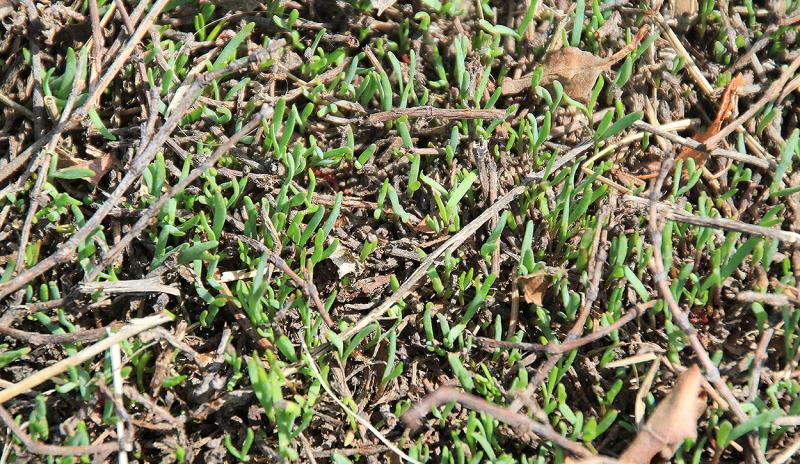
Prostrate Knotweed
Prostrate knotweed (Polygonum aviculare) is one of the earliest annual weeds to germinate. Seedlings can often be found as early as March. It is a common weed in cracks in pavement, where it will usually grow flat and spreads out into a mat that may reach 24 inches or more in diameter. While it can germinate at very low temperatures, it can also thrive during the heat and drought of summer, unlike many other spring or winter annuals. It usually doesn’t flower and set seed until the summer months. It is called knotweed because there is a characteristic swelling at each node along the fine, wiry stems.
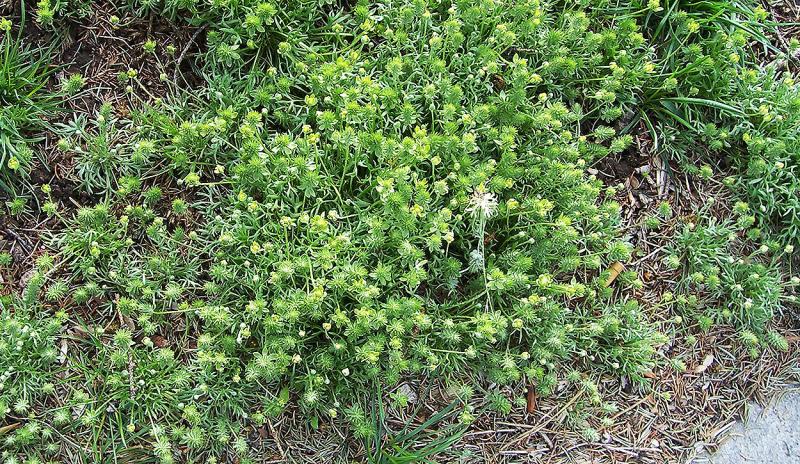
Bur Buttercup
Bur buttercup (Ceratocephala testiculata) is an early spring flowering, low-growing winter annual that usually flowers once temperatures reach the mid-40s to 50°F, setting seed by the first part of May. The plants are quite small, usually reaching no more than an inch or two in height. The flowers are only about one quarter inch across and mature into a spiny fruit, which can be quite painful to step on while barefoot. It also tends to grow in large mats containing many individual plants. It can be a difficult to control. Chemical weed controls labeled for use on bur buttercup will be most effective when applied to young seedlings that germinate in the fall.
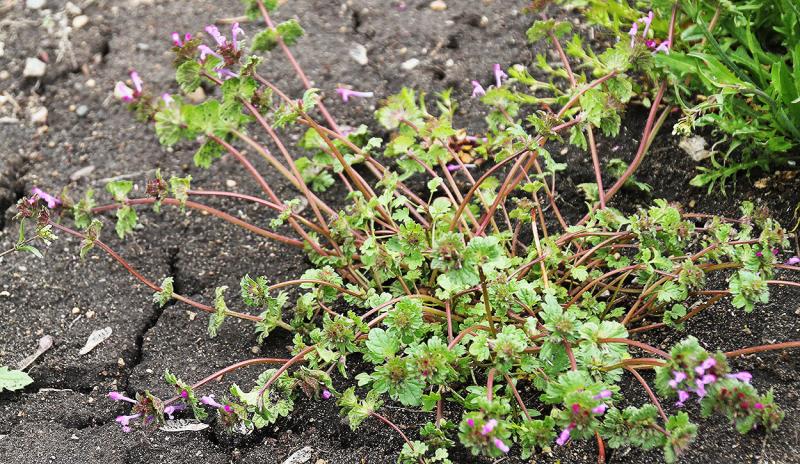
Henbit
Henbit (Lamium amplexicaule) may be a winter or spring annual that flowers very early in the spring. It can be a real problem in newly seeded lawns or bare areas in lawns or gardens. Since it is a member of the mint family, the foliage has a minty aroma when crushed or mowed. It has very small pink-to-lavender flowers that are borne in clusters around the stem at the nodes along the upright stems. The best control in a lawn is to keep the grass healthy so it can outcompete henbit. Over-seed bare areas of lawn, fertilize if that has not been done in recent years and raise the mowing height to at least 3 inches. Henbit does provide food for some types of birds, so it does have some merit in the garden.
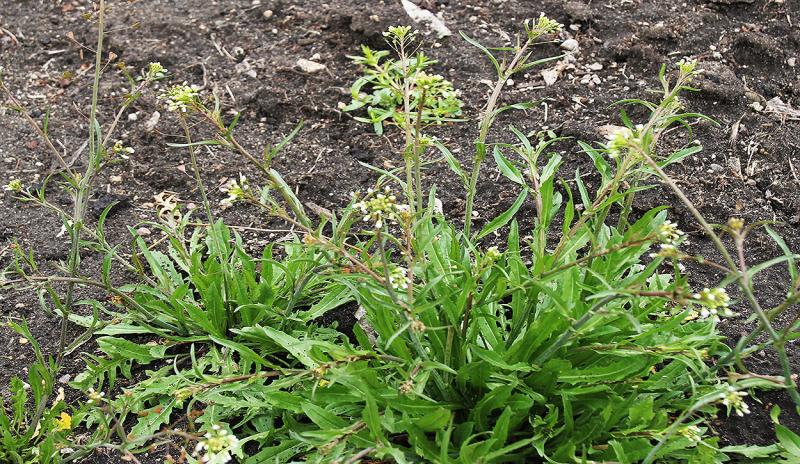
Shepherd’s Purse
Shepherd’s purse (Capsella bursa-pastoris) is a winter annual that can be found growing and flowering in both the spring and fall. The common name of shepherd’s purse refers to the triangular shape of the fruit, that resembles an old-fashioned coin purse. This weed produces lots of seed since each of the little “purses” are filled with seeds. Shepherd’s purse starts growth as a rosette of dandelion-like leaves before the flower stem develops that may reach 8 to 12 inches in height. It is a member of the Brassicaceae family, so it is related to cabbage, kale, broccoli and other related plants, and the leaves and seeds are edible.
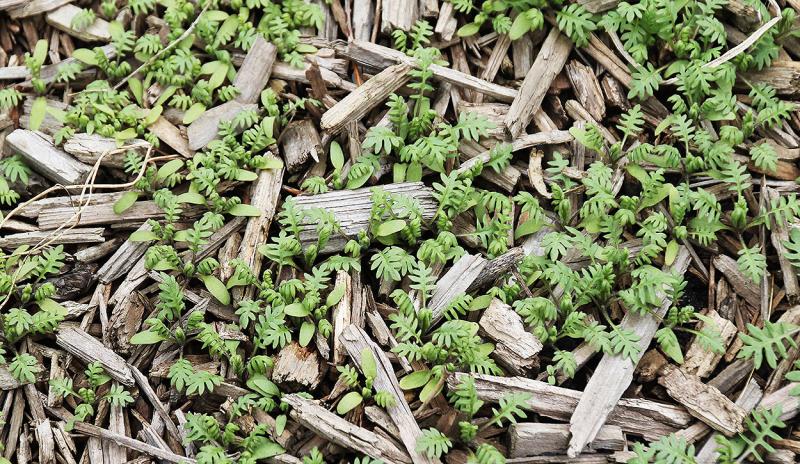
Waterpod
Waterpod (Ellisia nyctelea) is an annual that can tolerate moist conditions, and it is often seen growing up in patches in partial to full-shade locations. It has a distinctive pinnately lobed leaf. It can grow up to a foot tall. It has light blue flowers followed by small fruit that contain four seeds each. It is easy to pull out of the garden by hand or with a hoe when the plants are young, because it has a weak taproot.
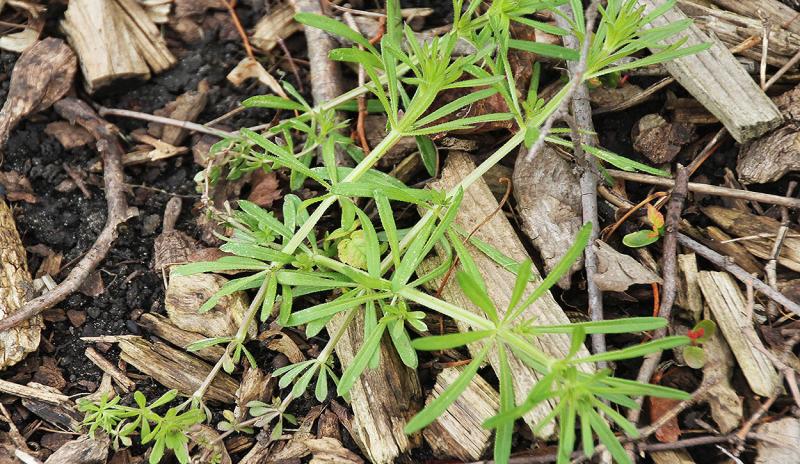
Catchweed Bedstraw
Catchweed bedstraw (Galium aparine) is another very common early-spring plant. It is easily distinguished by its finely textured palmately compound leaves and by the minute sticky hairs that cover the leaves. For this reason, this plant is sometimes called other common names, such as Velcro plant and sticky willy. It can be fun to play with, as it will adhere to most clothing. The Velcro-like feature is what allows this plant to be spread around as it hitches a ride on your clothing and your pet’s fur; aiding in seed distribution. The flowers are quite tiny, four-petaled and white or yellow. During the summer, plants may grow to four feet in height, spreading and becoming entangled in other garden vegetation. Catchweed bedstraw is fairly easy to remove from the garden when plants are young, but you must remove the very base of the plant, including the roots – the stems can be rather brittle and just break off, only to grow back again.
Managing Spring Weeds
The best way to prevent these weeds is to keep other kinds of groundcovers growing or use mulch or edging to help cover bare soil. Sometimes these weeds will be seen growing on the surface of mulch that has thinned or accumulated debris and soil within the mulch. Pre-emergent herbicides may provide some control but must be applied prior to weed seedling emergence, so in many cases would need to be applied in early April to beat out germination of these early spring annuals. Post emergent sprays are another option, but must be used with extreme caution as to not damage desirable, adjacent plants. As always, be sure to follow the label instructions. Hand weeding, pulling, or hoeing out the weeds are tried and true methods to remove these weeds without any unintended herbicide damage to your garden or lawn. Remember that if weeds are allowed to go to seed, they will just be a more severe problem next year.


